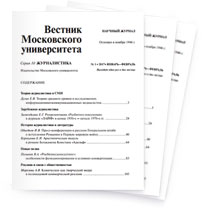Television Channels and Social Networks: Specifics of Interaction
Download paperDoctor of Philology, Professor at the Chair of Media Theory and Economics, Faculty of Journalism, Lomonosov Moscow State University, Moscow, Russia
e-mail: shgg@yandex.ruPhD in Philology, Associate Professor at the Chair of Television and Radio Broadcasting, Faculty of Journalism, Lomonosov Moscow State University, Moscow, Russia
e-mail: abiljo@mail.ruSection: Television and Radio
This article aims to present the results of an analysis of Russian television channels’ interaction with the Facebook, VKontakte and Odnoklassniki social networks. The analysis revealed the specifics of different Russian television channels’ presence and performance on these social networks. The authors present the main approaches of the channels’ content strategy for social media and examine the major shortcomings of the television channels’ activities on social networks.
DOI: 10.30547/vestnik.journ.3.2018.316References:
Adornato A., Lysak S. (2017) You Can’t Post It! Social Media Policies in U.S. Television Newsrooms. Electronic News 11 (2): 80–99.
Baranova E. A. (2016) Biznes-strategiya, osnovannaya na ispol‘zovanii resursov pol‘zovateley: opyt rossiyskikh SMI [The Business Strategy Based on the Use of User Resources: the Experience of Russian Media]. Vestn. Mosk. un-ta. Ser. 10: Zhurnalistika 4: 163–175. (In Russian)
Bullard S. (2015) Editors Use Social Media Mostly to Post Story Links. Newspaper Research Journal 36 (2): 170–183.
D‘yachenko O.V. (2014) Rossiyskie SMI v sotsial‘nykh setyakh Facebook i v «VKontakte»: praktiki vzaimodeystviya [Russian Media on the Facebook and VKontakte Social Networks: the Practices of Interaction]. Mediascope 4. (In Russian). Available at: http://mediascope.ru/node/1242 (accessed: 20.03.18).
Muronets O. V. (2015) Kontent sotsial’nykh setey: tendentsii i zakonomernosti [Content of Social Networks: Trends and Patterns]. Mediascope 3. (In Russian). Available at: http://mediascope.ru/node/1242 (accessed: 10.03.18).
Newman N. (2009) The Rise of Social Media and Its Impact on Mainstream Journalism. London: University of Oxford.
Pershina E. D. (2017) Printsipy vybora rossiyskimi novostnymi media ploshchadok dlya sozdaniya grupp v sotsial’nykh setyakh [Principles of Choosing Sites for Creating Groups on Social Networks Used by Russian News Media]. Mediascope 2. (In Russian). Available at: http://mediascope.ru/node/1242 (accessed: 19.03.18).
Shchepilova G. G. (2017) Telekanaly Krymskogo poluostrova v sotsial’nykh setyakh VKontakte i Facebook [TV Сhannels of the Crimean Peninsula on the VKontakte and Facebook Social Networks]. In Tezisy dokladov II Chernomorskoi mezhdunarodnoi nauchno-prakticheskoi konferentsiya MGU, 25–27 maya 2017 g. [Abstracts of the 2nd Black Sea International Research-to-Practice Conference at MSU, May 25-27]. Sevastopol: Moscow St. Univ. Publ in Sevastopol. Pp. 19–20. (In Russian)
Shchepilova G. G. (2018) Vzaimodeystvie SMI i sotsial‘nykh media [Interaction of the Media and Social Media]. In Rossiyskaya piarologiya-6: trendy i drayvery. St. Petersburg: SPbGEU Publ. Pp. 46–49. (In Russian)
Shirky S. (2008) Here Comes Everybody. The Power of Organizing Without Organizations. New York: Penguin Press.
Stefanone M. A., Lackaff D., Rosen D. (2010) The Relationship Between Traditional Mass Media and “Social Media”: Reality Television as a Model for Social Network Site Behavior. Journal of Broadcasting & Electronic Media 54 (3): 508–525.
Westerman D., Spence P., Van Der Heide B. (2013) Social Media as Information Source: Recency of Updates and Credibility of Information. Journal of Computer-Mediated Communication 19 (2): 69–84.






